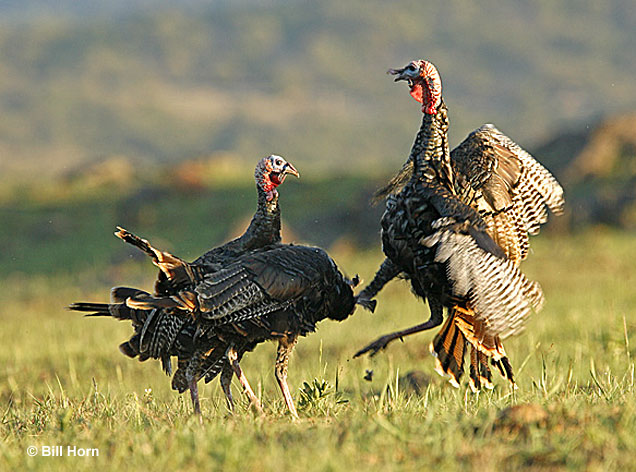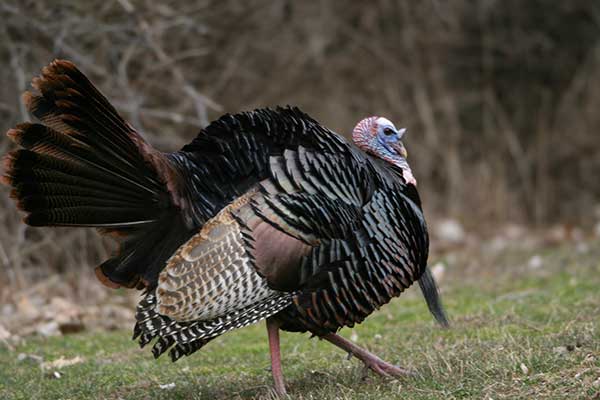Do you know the difference between a turkey and a chicken? A turkey has a gobble, whereas a chicken clucks. However, they’re not completely different. Both chickens and turkeys feed off the ground, are heavy-bodied, and are from the same family, Phasianidae.
We’ll go over everything you need to know about these two birds in this article so you can compare and contrast them.
Turkeys and chickens are opposites in almost every way. However, they have one very notable similarity. Both turkeys and chickens have wattles. The skin flaps that hang on either side of a chicken’s throat, directly behind its beak, are called wattles. Wattles help chickens and turkeys release excess heat.
Additionally, chickens have more colorful feathers in comparison to turkeys. Male chickens are usually brighter than female chickens.
Turkeys have darker plumage, a snood over their head, and a featherless neck and head. Male turkeys are more colorful than female turkeys.
Ah, the turkey. A centerpiece of Thanksgiving feasts, a symbol of abundance, and a source of endless culinary debate. But is it just a giant chicken? Let’s delve into the fascinating world of these feathered friends and uncover the truth behind their differences.
Size Matters: The Turkey’s Imposing Stature
The most obvious distinction between a turkey and a chicken is size. Turkeys are like the NBA players of the poultry world, towering over their chicken counterparts. A typical turkey can weigh up to 20 pounds, while a chicken usually clocks in around 5-7 pounds. This size disparity translates to longer cooking times and bigger appetites for turkey.
Flavorful Feats: A Tale of Two Tastes
When it comes to taste both turkey and chicken are considered white meat, but their flavor profiles differ subtly. Turkey boasts a deeper, more complex flavor, often described as “gamey.” Chicken on the other hand, tends to be milder and more familiar, especially for those accustomed to its everyday presence on our plates.
Cooking Conundrums: Mastering the Bird
While both turkey and chicken can be roasted, their size difference necessitates adjustments. Turkeys require lower temperatures and longer cooking times to ensure even doneness and prevent drying. Additionally, their larger size makes them ideal for slow-cooking methods like smoking or braising, resulting in melt-in-your-mouth tenderness.
Beyond the Basics: A World of Poultry Possibilities
Turkey and chicken are just the tip of the poultry iceberg. Ducks, geese, and even quail offer unique flavor experiences and cooking challenges. Duck, for example, boasts a rich, fatty flavor that pairs well with fruit-based sauces, while goose is known for its intense gaminess and crispy skin.
The Verdict: A Celebration of Culinary Diversity
So, is turkey just a big chicken? Not quite. While they share similarities as poultry, their distinct sizes, flavors, and cooking requirements set them apart. Ultimately, both turkey and chicken offer a delicious and versatile canvas for culinary creativity. Whether you’re a seasoned chef or a novice in the kitchen, exploring the world of poultry promises a flavorful adventure.
Turkey vs Chicken Behavior
Both turkeys and chickens can be very friendly and loving birds. But, each bird will have their own individual and unique personality. But generally speaking, turkeys behave differently from one another, whereas chickens behave similarly to one another.


It’s clear from their pairings that turkeys move more slowly than chickens and are more likely to follow rather than lead. Additioanlly, turkeys are more deliberate in their actions than chickens and are less skittish overall.
It’s uncommon, but turkeys have been known to try and attack or dominate people they view as subordinates. This behavior mainly occurs when it’s breeding season.
Although most chickens are not known to be violent, certain breeds can be dangerous to people and other animals.
Turkey vs Chicken Size
Chickens tend to be smaller than turkeys; they can reach a length of up to 2. 3 feet and weigh around 5. 5 pounds. The height range for hens is 14–20 inches, and the height range for roosters is 20–26 inches.
Turkeys, on the other hand, are larger. Wild and domesticated turkeys are known for their sheer size. They can reach a length anywhere from 3. 3 to 4. 1 feet and weigh around 24 pounds.
Turkeys can fly and have been known to fly short distances, up to a 1/4 of a mile. They can fly at high speeds of anywhere from 40 to 55 mph. These birds spend most of their time on the ground, but they must fly at night to roost in trees.


Like turkeys, chickens can fly but are not very good at it. They can’t fly very far and can’t fly very high, but they can fly.
These birds fly for the sole purpose of survival. They’re descendants of wild jungle fowl of Asia. They used their wings to roost in trees at night and escape predators. The farthest recorded distance of a chicken in flight was 301. 5 feet. The longest recorded flight of a chicken was 13 seconds.
On average, turkeys live longer than chickens. The average lifespan of a wild turkey is 3 to 5 years. The average lifespan of domestic turkeys is 10 years old.
Chickens are trickier when it comes to their lifespan because their average lifespan is more broad. Hens can live anywhere from three to seven years old, while most roosters can live anywhere from five to nine years.
